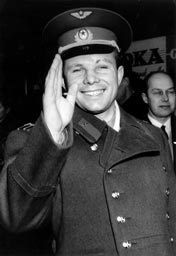<Back to Index>
- Cosmonaut Yuri Alekseyevich Gagarin, 1934
- Painter Aleksander Orłowski, 1777
- Explorer Amerigo Vespucci, 1454
Yuri Alekseyevich Gagarin (Russian: Ю́рий Алексе́евич Гага́рин; 9 March 1934 – 27 March 1968), Hero of the Soviet Union, was a Soviet cosmonaut. On 12 April 1961, he became the first human in outer space and the first to orbit the Earth. He received medals from around the world for his pioneering tour in space. Yuri Gagarin was born in the village of Klushino near Gzhatsk (now in Smolensk Oblast, Russia),
on 9 March 1934. The adjacent town of Gzhatsk was renamed Gagarin in
1968 in his honour. His parents, Alexey Ivanovich Gagarin and Anna
Timofeyevna Gagarina, worked on a collective farm. His
mother was reportedly a voracious reader, and his father a skilled carpenter.
Yuri was the third of four children, and his elder sister helped raise
him while his parents worked. Like millions of people in the Soviet Union, the Gagarin family suffered during Nazi occupation in World War II. His two elder siblings were deported to Nazi Germany for slave labour in
1943, and did not return until after the war. After starting an apprenticeship in a metalworks as a foundryman, Gagarin was selected for further training at a technical high school in Saratov.
While there, he joined the "AeroClub", and learned to fly a light
aircraft, a hobby that would take up an increasing proportion of his
time. In 1955, after completing his technical schooling, he entered
military flight training at the Orenburg Pilot's School. While there he met Valentina Goryacheva, whom he married in 1957, after gaining his pilot's wings in a MiG-15. Post-graduation, he was assigned to Luostari airbase in Murmansk Oblast, close to the Norwegian border,
where terrible weather made flying risky. As a full-grown man, Gagarin
was 1.57 metres (5 ft 2 in) tall, which was an
advantage in the small Vostok cockpit. He became Lieutenant of the Soviet Air Force on 5 November 1957 and on 6 November 1959 he received the rank of Senior Lieutenant. In 1960, after the search and selection process, Yuri Gagarin was selected with 19 other cosmonauts for the Soviet space program.
Along with the other prospective cosmonauts, he was subjected to
experiments designed to test his physical and psychological endurance;
he also underwent training for the upcoming flight. Out of the twenty
selected, the eventual choices for the first launch were Gagarin and Gherman Titov because of their performance in training, as well as their physical characteristics — space was at a premium in the small Vostok cockpit and both men were rather short. On 12 April 1961, Gagarin became the first man to travel into space, launching to orbit aboard the Vostok 3KA-3 (Vostok 1). His call sign in this flight was Kedr (Cedar; Russian: Кедр). During his flight, Gagarin famously whistled the tune "The Motherland Hears, The Motherland Knows" (Russian: "Родина слышит, Родина знает"). The first two lines of the song are: "The Motherland hears, the Motherland knows/Where her son flies in the sky". This patriotic song was written by Dmitri Shostakovich in 1951 (opus 86), with words by Yevgeniy Dolmatovsky. Around
the same time, some Western sources claimed that Gagarin, during his
space flight, had made the comment, "I don't see any God up here."
However, no such words appear in the verbatim record of Gagarin's
conversations with the Earth during the spaceflight. In a 2006 interview a close friend of Gagarin, Colonel Valentin Petrov, stated that Gagarin never said such words, and that the phrase originated from Nikita Khrushchev's speech at the plenum of the Central Committee of the CPSU,
where the anti-religious propaganda was discussed. In a certain context
Khrushchev said, "Gagarin flew into space, but didn't see any God
there". Colonel Petrov also said that Gagarin had been baptised into the Orthodox Church as a child. After the flight, Gagarin became a worldwide celebrity, touring widely with appearances in Italy, Great Britain, Germany, Canada, and Japan to promote the Soviet achievement. In 1962, he began serving as a deputy to the Supreme Soviet of the Soviet Union. He later returned to Star City,
the cosmonaut facility, where he worked on designs for a reusable
spacecraft. Gagarin worked on these designs in Star City for 7 years.
He became Lieutenant Colonel of the Soviet Air Force on 12 June 1962 and on 6 November 1963 he received the rank of Colonel of the Soviet Air Force. Soviet
officials tried to keep him away from any flights, being worried of
losing their hero in an accident. Gagarin was backup pilot for Vladimir Komarov in the Soyuz 1 flight.
As Komarov's flight ended in a fatal crash, Gagarin was ultimately
banned from training for and participating in further spaceflights. Gagarin then became deputy training director of the Star City cosmonaut training base. At the same time, he began to re-qualify as a fighter pilot. On 27 March 1968, while on a routine training flight from Chkalovsky Air Base, he and flight instructor Vladimir Seryogin (Seregin) died in a MiG-15UTI crash near the town of Kirzhach. Gagarin and Seryogin were buried in the walls of the Kremlin on Red Square.
